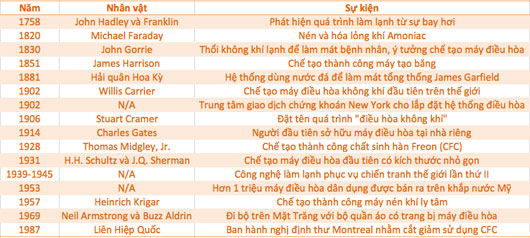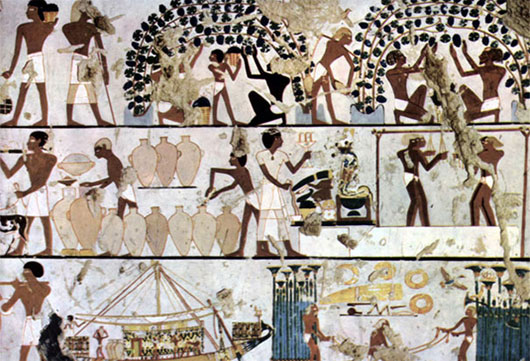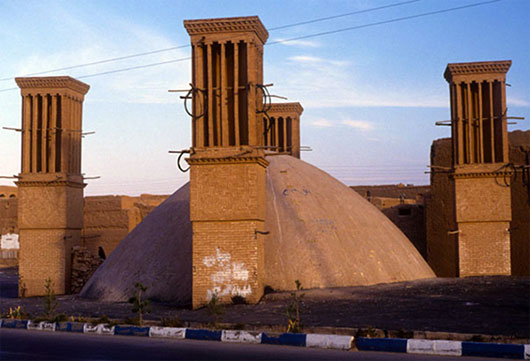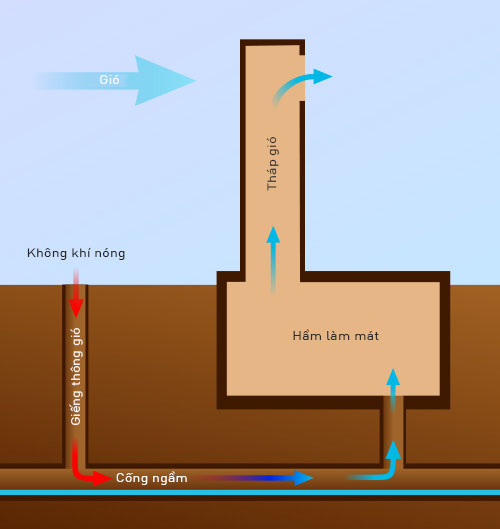History of formation and development of air conditioners
Air-conditioner (air conditioner) is a popular household electrical product all over the world. Especially in a tropical country like Vietnam, being able to live and work in a cool environment created by air conditioning is the need of everyone. During the hot summer days like today, the air conditioner is an indispensable product for each of us.
Today, they will learn about the history of air conditioning, from the oldest models to the modern air conditioning you are using today. Again encountered the ancient Egyptians .
Summarize the important milestones in the development of modern air conditioners

The earliest models - Humans have known to cool since ancient times .

The picture on the wall depicts the cooling method of ancient Egyptians
Archaeologists and historians argue that the earliest model of air conditioning was adopted by ancient Egyptians by hanging reeds on windows and spraying water up. When the wind blows through the window will bring in steam and cool the air inside the room. In addition, this method also helps ancient Egyptians to moisten the indoor atmosphere, avoiding the hot dryness of the desert climate.

Pictures of cooling towers of Persians
Ancient Romans also installed plumbing around the walls to circulate water to cool the house. Another technique is also used by medieval Persians to cool the air. It is a system that includes water tanks and wind towers to cool indoor air at hot times.

Operation diagram of cooling tower system
In the 2nd century Han Dynasty in China, inventor Dinh Hoan created a "fan" to cool the air. This is a system of 3 wheels with a diameter of 3 meters and is rotated by hand to create the wind flow. In 747, King Tang Xuanzong (712-762) used a cooling tower installed in a palace called Quant Thien. Ancient texts have described the system to include spinning wheels with water power to create a humid airflow that cools the air. Until the Song Dynasty in China, ancient documents also mentioned the use of the above air cooling system widely by many different subjects.
All inventions start from the physical-chemical principles
By the 17th century, inventor Cornelis Drebble (1572-1633) introduced a model of making air machines by adding salt to water. He named this system "turning summer into winter" and introduced it to the King of England at that time, James I.

Inventor John Hadley (1731-1764), who discovered the relationship between liquid evaporation and cooling process
In 1758, Benjamin Franklin (1785-1788), governor of Pennysylvania, and John Hadley (1731-1764), a professor of chemistry at Cambridge University conducted experiments and discovered the principle of evaporation. Franklin and Haldley confirmed that the evaporation of a liquid such as alcohol or ether can be used to reduce the temperature of an object below the freezing point of water. Two people conducted a test using evaporation to lower the temperature of the mercury thermometer tube from 18 degrees C to -14 degrees C.
Franklin noted that as soon as the temperature crossed the freezing threshold of water, a thin film of ice formed on the surface of the thermometer tube. Since then, he has come to the conclusion: "The experiment shows that freezing a man to die right in the summer is a perfectly feasible job".

British chemist, physicist and inventor, Michael Faraday (1791-1867), who first performed experiments to compress and liquefy ammonia and discovered cooling from the opposite process.
By 1820, the British chemist and inventor, Michael Faraday (1791-1867), successfully experimented with the compression and liquefaction of ammonia gas. He discovered that when evaporated, liquid ammonia could cool the surrounding air. More than 20 years later, in 1842, Scottish physician John Gorrie (1803-1855) used air compression techniques to create bandages to cool patients in hospitals in Apalachicola, Florida. From that success, he hopes to create a tape making machine to cool an entire building. Even Dr. John envisioned a machine that could cool the air for an entire city.

Scottish doctor John Gorrie (1803-1855), who gave the first idea of air cooling system.
Although the model and these ideas have never been implemented, in 1851, Gorrie was granted a patent for the tape-making machine . However, supporters of Gorrie's cooling machine project died and he could not get the aid money to make the fabrication. Right now, Gorrie has suffered many objections from contemporary inventors. Finally, Gorrie died in poverty in 1855 and the idea of an air cooler faded away for many years afterwards.

John Gorrie's tape making machine model is kept at John Gorrie Museum, Apalachicola, Florida
From another point of view, since prehistoric times, snow and ice have been used for cooling. Until the 19th century, winter ice gathering and reserve for summer use became a popular industry. And with the development of science and technology, the model of mechanical ice making machine soon appeared.

Engineer James Harrison, the first person to successfully build a tape making machine in 1851
The first ice making machine built by engineer James Harrison was officially operated in 1851 on the banks of the Barwon River at Rocky Point in Geelong, Australia. Later, Harrison's ice making machine was officially commercialized in 1854. A year later, he was awarded a patent for the invention of the ether-compressed refrigerator system in 1855.
In principle, Harrison's system uses compressors to push air through a condenser. Air flow will be cooled and liquefied. Next, liquefied gas will move through the pipe system and return to the vapor. This process will cool the surrounding air. The machine is operated by a 5 meter diameter flywheel and can produce 3000kg of ice water every day.

Picture of Harrison's tape making machine
Although Harrison had successfully commercialized the second ice factory in Sydney in 1860, his development had suffered a serious failure not long after. In the 1870s, the issue of competition in the European market between Australia and the US was a hot topic. At that time, Harrison conducted a test of transferring beef from Australia to England on transport ships. Instead of installing the refrigerator, Garrison installed a room filled with ice to preserve the beef. The result is that all meat is damaged by gliding ice used to dissolve faster than Garrison expected.
Ice-cooled models continue to be used later in the United States. In 1881, when President James Garfiels was assassinated and in the hospital room, a group of US naval engineers built an air blower through a cloth containing ice to cool the air. The system can keep the room temperature at 20 degrees Celsius, consuming millions of kilograms of ice water for a period of two months until the president dies.
Mechanical and refrigeration model - The first air conditioner appeared
At the end of the 19th century, the concept of "air production" began to appear. However, this is only a method of controlling humidity in textile factories to achieve higher productivity levels. Then, a cooling system was set up from the humid air pipes that circled the building to preserve food, cool beer, drinks or to protect important documents.

Inventor Willis Carrier (1875-1950) - The first person to invent a modern air conditioner
In 1902, the first modern air conditioner model operated by electrical energy was invented by Willis Carrier (1875-1950) in Buffalo, New York. After graduating from Carnell University, Carrier started working for mechanical company Buffalo Forge. During the work here, Carrier began conducting air cooling experiments. Finally, the air conditioner model was designed and manufactured officially by Carrier on July 17, 1902 in Buffalo.

Willis Carrier is operating the world's first modern air conditioning system
The first air-conditioning system was designed to be used for a printing factory, so Carrier's invention not only controlled the temperature but also the humidity of the air in the plant. To do this, Carrier applied his knowledge of the process of heating an object with steam and figuring out how to reverse that process. The principle is quite simple, instead of pushing air through a heating tube, he creates a flow that moves air through a cooled tube with liquefied ammonia.

Design of air conditioning system of Carrier in 1902
The system consists of 2 main conduits, 1 tube for air cooling and 1 tube to supply moisture containing air. As a result, the system can control humidity at 55% inside the chilled air mass. Therefore, the refrigeration system can preserve the equipment in the factory and create the best conditions to carry out the printing process. With this cooling system, Carrier is dubbed the father of modern air conditioning models.
According to some notes and accounts, the idea of the system appeared when Carrier was on a train in the fog. After that, Carrier's technology was applied to improve productivity in offices, factories, . And the air conditioner manufacturing company called Carrier was officially established in the US to meet the increasing demand for use. However, the first air conditioning system was very large, extremely expensive and very dangerous due to the use of ammonia as a biochemical, which is a highly toxic compound.
In 1906, engineer Stuart Cramer, working at the Northern California textile factory, came up with the idea of making a ventilator fitted into a pot of distilled water in a textile system to create moisture to make the weaving process easy. than. Cramer called this process "air conditioning".

The group of engineers at Buffalo Forge, Carrier stood in the middle row, the third from right
Soon after the success of the first air conditioner model, also in 1902, the New York Stock Exchange Center installed a central cooling system in parallel with a heating system designed by Alfred Wolff, an engineer from Hoboken, New Jersey state. Wolff is an engineer known for upgrading the design of textile machinery and incorporating it into building design. He is seen as a model in creating revolutions that apply science and technology.
The stage of improvement and dissemination of air conditioning

The home of the famous gambler Charles Gates, the first person in the world to equip air conditioning at home.At that time, Gates had to spend $ 60,000 per year to maintain the entire house.
Temperature and humidity control systems have contributed to the development of many other industries such as film making, food, tobacco, pharmaceuticals, textiles and many other industries. In 1911, Carrier continued to introduce a "cooling formula with a reasonable moisture ratio" to the American Society of Mechanical Engineers. This cooling method is still applied today in some areas of the refrigeration industry.
In 1914 in Minneapolis, the first household installed an air conditioning system built by Carrier. This is the home of the famous gambler Charles Gates, who was dubbed the "million dollar card". Gates air conditioner has a height of 2.1 meters, 1.8 meters wide and is nearly 7 meters long. However, the machine was never used because no one lived in the house but every year, Gates had to spend more than $ 60,000 to maintain the entire house.

Image of Carrier and air conditioning system placed on the roof of a building
From 1917 to 1930, the main cinema where people can enjoy the air cooled by air conditioning. The first air-conditioned cinema was New Empire Cinema in Montgomery, Alabama in 1917. That same year, Central Park Theater in Chicago quickly installed air conditioning systems and received a warm response from customers, especially on summer days.

Koan Maru, the first ship to be equipped with an air conditioning system in 1937
In 1922, Carrier continued to create two breakthrough steps for the air conditioner manufacturing industry. The first is to replace the toxic ammonia biochemical with another safer compound, dielene (dichlorethylene, or C 2 H 2 Cl 2 ) . In addition, the next generation of air conditioners have been minimized by Carrier and produced much more compact machines than before. This innovative step allows air conditioners to be installed in more places such as department stores, office buildings, ships or small buildings.

A photo of a department store equipped with air conditioning (a high cabinet placed next to the cashier)
Next, the period from 1924 to 1930 witnessed the popularity of air conditioners to many US government agencies such as the Senate, the House of Representatives, the White House, the commercial center and many other important buildings. across the United States. At this stage, the biochemical substances commonly used in refrigeration techniques of air conditioners include ammonia, methyl chloride or propane.

American engineer Thomas Midgley, Jr.(1889-1944) the first successful production of Freon (CFC), a common welding agent in refrigeration technology.
In 1928, American engineer Thomas Midgley, Jr. (1889-1944) Freon successfully produced for the first time , inert, difficult to burn, non-toxic gas for humans. Freon gas (Chlorofluorocarbon or CFC) was quickly used as a biochemical in refrigeration technology and was widely used for air-generation until 1994 later.
In 1931, HH Schultz and JQ Sherman successfully built the first compact air conditioner that fits comfortably on a window sill and cools 1 room space. This generation of air conditioners was officially commercialized a year later but only served the upper classes because the cost of manufacturing was too expensive: between $ 10,000 and $ 50,000 (equivalent to $ 120,000 to $ 600,000 currently in.)
World War II broke out - Air conditioner for war

A flyer of air conditioner from Carrier
After that, due to the impact of the great crisis, the demand for air conditioners decreased sharply and the development of the cooling industry was also suspended. To change the issue, in the world fair in 1939, Carrier performed an igloo cooled by his system in the presence of millions of people. Carrier hopes to find a brighter future for this industry in the future. However, hope has not been fulfilled due to the outbreak of the Second World War.

The advertisement shows the use of air conditioners to refresh military food for the war.
Until the outbreak of World War II, most factories turned to producing products to serve the war. In many places, air conditioners are disassembled from stores to be used for military production plants. During this time, thousands of air conditioners were produced to keep the army's food fresh and undamaged.

The Liberty Fleet warship, the battleship is fully equipped with an air cooling system for cooling soldiers, keeping fresh food and chilling drinking water.
In hot climates, air conditioners are also used to preserve fighters. In order to contribute to the war, Carrier also proposed to use air conditioners to simulate environmental conditions in the air right at the ground to test aircraft, which is something no contemporaries think of. As well as this contribution, Carrier was awarded many noble titles by both the military and industrial companies.
From after the war to the present day: Air conditioning is increasingly being improved in the direction of small, light, high-performance and environmentally friendly.

A model of home air conditioning systems in the 1940s
After World War II, non-military products were produced normally and the economy in the US began to flourish. American people started shopping for air conditioners and enjoying the cool atmosphere at home. The cost of making cheaper and cheaper equipment makes air conditioners become popular appliances in the US.
Until 1946, 30,000 home air conditioners were produced and supplied to people throughout the United States. Demand for air conditioners at that time exceeded supply. Until 1953, more than 1 million air conditioners were produced and sold throughout the United States, but according to unorthodox figures, the actual number was far above those statistics.

Photos of air conditioners are installed outside the lecture hall at the University of California
1957 marked the spectacular transformation of air-conditioning technology with the successful creation of the world's first centrifugal compressor by Heinrich Krigar. This technique allows the manufacture of new air-conditioner models with small size, light weight, quiet operation and higher performance than previously used piston compressing techniques.
In 1969, it was the refrigeration technology that facilitated the successful trip to the Moon. 2 astronauts Neil Armstrong and Buzz Aldrin took a walk on the Moon with astronaut clothes equipped with a cooling system against space conditions.

Photo of the conference issuing the Montreal Protocol in 1987 on the issue of protecting the ozone layer with the participation of heads of state and many leading industry leaders
In 1987, the United Nations issued the Montreal Protocol to protect the Earth's ozone layer. The Protocol stipulates countries that restrict the use of waste-generating methods that pollute the environment and puncture the ozone layer. These include CFC cooling techniques, compounds mainly used in air conditioners and refrigerators.
Next time, air conditioners continue to be improved in size, cooling performance and especially using new, more environmentally friendly cooling methods. Air-conditioner manufacturers start rolling out refrigerated products that do not contain. Along with the development of science and technology, the environmentally friendly and high-performance cooling methods are applied to air-conditioners such as Linde cooling techniques, magnetic cooling, .

Air conditioners using Inverter technology are gaining popularity today
Until recently the inverter air conditioner technology. This is a generation of air-conditioners using inverter technology to change compressor frequency to achieve the desired temperature with minimum thermal amplitude, thereby saving power consumption. According to industry experts, this will be the most widely used air conditioner in the present as well as in the future.
- History of formation and development of nuclear energy
- 400 year history of battery formation and development
- Astronomers map the history of the Universe
- History of currency development
- The formation and development of locks and keys
- Bill Gates announced the Big History Project: History of 13.7 billion years of the universe
- History of formation and development of ice cream
- Air conditioners save electricity
- History of Modem
- Automobile air conditioners, solar
- Bicycle development history
- Space History will be rewritten?
 'Fine laughs' - Scary and painful torture in ancient times
'Fine laughs' - Scary and painful torture in ancient times The sequence of numbers 142857 of the Egyptian pyramids is known as the strangest number in the world - Why?
The sequence of numbers 142857 of the Egyptian pyramids is known as the strangest number in the world - Why? History of the iron
History of the iron What is alum?
What is alum?